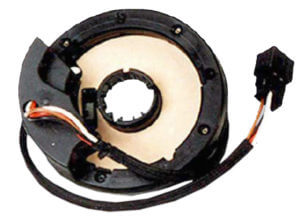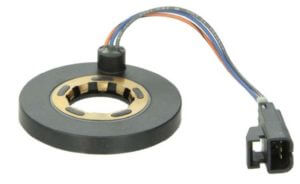Steering angle sensor calibration
Steering angle sensor and calibration
In order for collision avoidance systems (Advanced driver-assistance systems or ADAS) to work properly, the system must first know the driver’s intention. If you intend to change lanes and the system knows that, it won’t make the false assumption that you’re making an unintended lane change. So how do you let ADAS? Well, one critical component is the steering angle sensor.

Which ADAS systems use the steering angle sensor?
Lane departure warning
Driver monitoring system
Lane centering
Lane change assistance
Analog steering angle sensor
Some steering angle sensors generate and analog voltage signal that rises and falls depending on how the wheel is moved. Those sensors have 5-wires; a 5-volt reference signal, ground, and signal output. The signal moves from 0-volts to 5-volts as you turn the wheel. In fact, if you turn the wheel lock-to-lock, you may see the voltage change from 0-volts to 5-volts three times during the full turn.
Most carmakers’ steering angle sensor generates a positive voltage when turning right and a drop in voltage when turning left.
Digital steering angle sensor
Other vehicles use a digital steering angle sensor. These sensors incorporate a notched wheel, an LED light source, and a photoreceptor. As the notched wheel passes between the lights source and the receptor, the sensor can determine the direction and rate of rotation.
Torque sensor
The torque sensor determines exactly how much  force the driver is applying during the turn. It’s similar in design to the older mechanical spool valves used in hydraulic power steering systems to determine how much power assist is needed during a turn.
force the driver is applying during the turn. It’s similar in design to the older mechanical spool valves used in hydraulic power steering systems to determine how much power assist is needed during a turn.
The steering shaft is splined to a magnetic rotor in the center of the sensor. Pole pieces are located on a torsion bar to measure the amount of twist during steering movements.

Steering angle sensor calibration
Since the SAS is calibrated at the factory, there’s no need to recalibrate unless the vehicle is in an accident or service is performed on the steering or suspension system. For example, if you replace the rack and pinion gear, tie rods or tie rod ends or control arms you must perform an alignment and an SAS recalibration.
In addition, if you move the wheels during service while the ignition is off, you may have to recalibrate the SAS.
Some ADAS systems auto-recalibrate. Others can be recalibrated by grounding specific wires or pressing a recalibration button. Still others require recalibration with a professional-grade scan tool.
What happens if the steering angle is out of calibration?
You will most likely see a warning light for the ADAS system as well as a warning light for the ABS, Traction control or stability control system since neither of these can operate while there’s an active SAS trouble code.
©, 2019 Rick Muscoplat
Posted on by Rick Muscoplat
